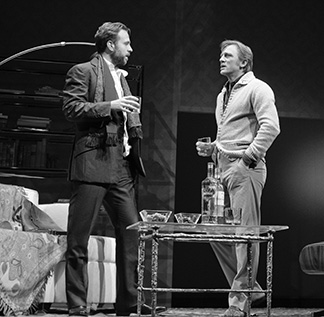Betrayal (1978) overview
- The Betrayal By Harold Pinter Summary
- The Betrayal Harold Pinter Restaurant
- Betrayal Harold Pinter Movie
- The Betrayal Play By Harold Pinter
- The Betrayal Harold Pinter Play
Harold Pinter’s 1978 play employs a reverse-chronological structure to tell the story of an extra-marital affair. Inspired by Pinter’s own seven-year affair with Joan Bakewell – who would also write a play, Keeping in Touch, in order to tell her side of the story – Betrayal is a three-hander in which a number of different betrayals are shown to take place.
Emma is having an affair with Jerry, a close friend of her husband, Robert. Jerry is also married, to Judith. For five years this relationship is clandestine, but then Emma confesses her infidelity to Robert – producing another betrayal in the context of the play.
The scenes unfold in reverse order. The play starts in 1977, when Jerry and Emma meet in a pub for the first time since the affair had ended two years previously. It’s a scene of restraint and melancholy; the pain is only semi-softened by the passing of time. The play’s final scene ends when the affair begins, in 1968, at a party in which Jerry declares his love for Emma.
The Betrayal By Harold Pinter Summary

- Complete summary of Harold Pinter's Betrayal. ENotes plot summaries cover all the significant action of Betrayal.
- Harold Pinter, (born Oct. 10, 1930, London, Eng.—died Dec. 24, 2008, London), English playwright, who achieved international renown as one of the most complex and challenging post-World War II dramatists.His plays are noted for their use of understatement, small talk, reticence—and even silence—to convey the substance of a character’s thought, which often lies several layers beneath.
Broadway Review: ‘Betrayal’ With Tom Hiddleston The impeccable London revival of Harold Pinter’s “Betrayal,” with Hiddleston, Charlie Cox, and Zawe Ashton, transfers to Broadway. Betrayal is Pinter's latest full-length play since the enormous success of No Man's Land.The play begins in 1977, with a meeting between adulterous lovers, Emma and Jerry, two years after their affair has ended. In Harold Pinter's Betrayal, an affair and its revelation are portrayed in reverse chronological order. William McEvoy explores how this reversal focuses our attention on the ways in which meaning and knowledge are constructed, and on the ability of language to hide as much as it reveals.
There are nine scenes in all. Emma and Jerry acquire a small London flat in which to conduct their affair. The pivotal scene takes place in a hotel room in Venice where Robert and Emma are on holiday. Robert discovers Emma has received a letter from Jerry, and Emma admits she’s been having an affair with him.
Both the affair and Robert and Jerry’s friendship continue after this, though the relationship between all of them has altered. The play’s particular chronology lends an extra emotional weight to each scene. The audience knows where the characters are headed and the impact of their choices on all of their lives. The dialogue is typically economical, but Pinter loads it with meaning and power-play between all three characters.
Key productions of Betrayal
Betrayal was first produced by the National Theatre in 1978, with Penelope Wilton as Emma, Michael Gambon as Jerry and Daniel Massey as Robert. It has been revived many times since, in many countries. Peter Hall directed its Broadway premiere in 1980. A 2011 West End production was directed by Ian Rickson and starred Kristin Scott Thomas, Douglas Henshall and Ben Miles.
The Betrayal Harold Pinter Restaurant
Betrayal (1978) overview
Betrayal Harold Pinter Movie

Harold Pinter’s 1978 play employs a reverse-chronological structure to tell the story of an extra-marital affair. Inspired by Pinter’s own seven-year affair with Joan Bakewell – who would also write a play, Keeping in Touch, in order to tell her side of the story – Betrayal is a three-hander in which a number of different betrayals are shown to take place.

Emma is having an affair with Jerry, a close friend of her husband, Robert. Jerry is also married, to Judith. For five years this relationship is clandestine, but then Emma confesses her infidelity to Robert – producing another betrayal in the context of the play.
The scenes unfold in reverse order. The play starts in 1977, when Jerry and Emma meet in a pub for the first time since the affair had ended two years previously. It’s a scene of restraint and melancholy; the pain is only semi-softened by the passing of time. The play’s final scene ends when the affair begins, in 1968, at a party in which Jerry declares his love for Emma.

The Betrayal Play By Harold Pinter
There are nine scenes in all. Emma and Jerry acquire a small London flat in which to conduct their affair. The pivotal scene takes place in a hotel room in Venice where Robert and Emma are on holiday. Robert discovers Emma has received a letter from Jerry, and Emma admits she’s been having an affair with him.
Both the affair and Robert and Jerry’s friendship continue after this, though the relationship between all of them has altered. The play’s particular chronology lends an extra emotional weight to each scene. The audience knows where the characters are headed and the impact of their choices on all of their lives. The dialogue is typically economical, but Pinter loads it with meaning and power-play between all three characters.
Key productions of Betrayal
The Betrayal Harold Pinter Play
Betrayal was first produced by the National Theatre in 1978, with Penelope Wilton as Emma, Michael Gambon as Jerry and Daniel Massey as Robert. It has been revived many times since, in many countries. Peter Hall directed its Broadway premiere in 1980. A 2011 West End production was directed by Ian Rickson and starred Kristin Scott Thomas, Douglas Henshall and Ben Miles.